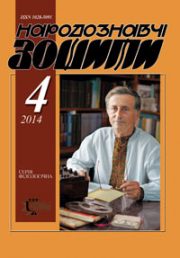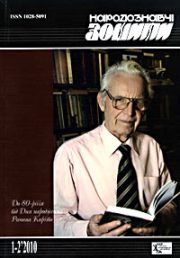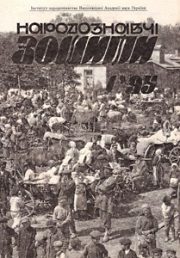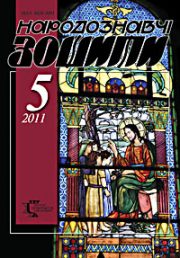The Ethnology Notebooks. 2023. № 4 (172), 951—963
UDK [392.51:635.054](=161.2:292.451/.454)
DOI https://doi.org/10.15407/nz2023.04.951
ALLOFORMS OF THE CERTAIN TREE IN THE TRADITIONAL WEDDING RITE OF UKRAINIANS OF THE CARPATHIANS
NAKONECHNA (HOSHCHITSKA) Tetiana
- ORCID ID: https://orcid.org/0000-0001-8596-8974
- Doctor of Philosophy, researcher fellow
- of department of Historical Ethnology
- of the Institute of Ethnology
- The National Academy of Sciences of Ukraine,
- 15, Svobody ave., 79000, Lviv, Ukraine,
- Contacts: e-mail: hoshchitska.tetiana@gmail.com
Abstract. Introduction: The traditional wedding ritual of Ukrainians in general, and of the Highlanders in particular, was one of the most important parts of family rituals, it was a complex of actions, resistant to transformations and saturated with various archaic features. Problem Statement: An important and comprehensive attribute of the traditional wedding rituals of the Ukrainian highlanders was the wedding tree, which on the one hand acted as a symbolic embodiment of the individual in the ritual, and on the other, played the role of a kind of «bridge» or «road» between the world of the living and the afterlife. In the area of the Ukrainian Carpathians, it lived not only in the form of a decorated tree, which is familiar to us, but also in alloforms (wedding banner and loaf of bread), which, although different from the outside, carried a similar semantic load.
The purpose of the proposed exploration is an attempt to comprehensively outline the picture of the existence of alloforms of the ritual tree in the marriage rituals of Ukrainian highlanders, to determine the degree of local specificity in the all-Ukrainian context, and to investigate their semantics.
The object of the study is the wedding ritual of the Ukrainian Carpathians, and the subject is the aloforms of traditional wedding tree, as its important attribute.
The scientific novelty in that for the first time an attempt was made to comprehensively examine the habitation of alloforms of the ceremonial tree in the area of the Ukrainian Carpathians.
The main methods used by the author are structural, typological analysis, historical reconstruction and comparative methods. Results: From the analyzed materials, in the wedding rite of the Highlanders we see a combination of a loaf and a ceremonial tree, even a fusion of their images in traditional representations. All this, in our opinion, points in favor of the statement about the embodiment of the symbolism of the world tree in this attribute, a certain ritual «center», a kind of reference point, which was necessary for the functioning of the ritual.
Keywords: ceremonial tree, wedding banner, loaf of bread, wedding rituals, family rituals, Ukrainian Carpathians, Bojky, Lemky, Hutsuls.
Received 21.06.2023
REFERENCES
- Mysevych, O. (1937). Ukrainian wedding ceremony in Boykivshchyna. Lviv [in Ukrainian].
- Borysenko, V. (1988). Wedding customs and rites in Ukraine: a historical and ethnographic study. Kyiv: Naukova dumka [in Ukrainian].
- Nesen, I. (2007). The wedding ritual of Central Polissia: traditional structure and relict forms (mid-19th—20th centuries). Kyiv [in Ukrainian].
- Warhol, Y. (2019). Calendar and family rituals of Ukrainians in Slovakia. Kyiv: IMFE [in Ukrainian].
- Zhatkovich, Yu. (2007). Ethnographic sketch of the Ugro-Russians: comprehensive edition. Uzhhorod: Art line [in Ukrainian].
- Kmit, Yu. (1936). Dictionary of the Boyky dialect (Part V). Chronicle of Boykivshchyna, VI/ 7, 61—76 [in Ukrainian].
- Syavalko, E. (1987). Folk customs and ceremonies. Family rituals. In: Hutsul region: historical and ethnological study (Pp. 302—318) [in Ukrainian].
- Gura, A.W. (1995). Wedding tree. In: Slavic antiquities: Ethno linguistic dictionary (Vol. 2, рр. 83—84). Moscow: Mezhdunarodnyye otnosheniya [in Russian].
- Bardavelidze, V. (2006). Ancient religious beliefs and ritual graphic art of the Georgian tribes. Tbilisi: Caucasian House [in Russian].
- Boplan, H. (1990). Description of Ukraine. Lviv: Kamenyar [in Ukrainian].
- Zhelem, M. (2008). Matsyna Velyka — is a Lemkiv village. Historical and local history essay. Drohobych [in Ukrainian].
- Yakivchuk, A. (2010). Wedding in the village of Goshova. Record of 1966. Annals of Borshchivshchyna, 10, 18—57 [in Ukrainian].
- Gerus, L. (2018). Bread and fabric in the ritual of Ukrainians: functions and content load. The Ethnology notebooks, 5, 1100—1105 [in Ukrainian].
- Agapkina, T. (1998). The mythology of trees in the traditional culture of the Slavs: hazel (Corylus avellana). In Studia mithologica slavica (Vol. I, pp. 183—194) [in Russian].
- Markovych, M. When people were afraid of the camera: how the first photographer Amaliya Kozhminova worked in Transcarpathia). Local history. Multimedia online platform about the past and present of Ukraine. Retrieved from: https://localhistory.org.ua/texts/reportazhi/koli-liudi-boialis-fotoaparata-iak-na-zakarpatti-pratsiuvala-persha-fotografka-amaliia-kozhminova/?fbclid=IwAR24o-f9WYsBs1TazF-w1VBjj3pTOYki2p5xbyXOUqrHLl9NF4NUJY3M5gc) (Last accessed: 19.03.2023) [in Ukrainian].
- Lenno, T. (2015). Traditional wedding ceremonies of the Boyki of Transcarpathia: mid-20th century — beginning of 21st century (Kandidat dissertation). Institute of Folklore, Ethnography and Art History named after M.T. Rylskyi) [in Ukrainian].
- (2020). Ethnographic image of modern Ukraine. Corpus of expeditionary ethnographic and folklore materials. Folk housing culture. Ecology and organization of habitat (Vol. 6). Kyiv: IMFE [in Ukrainian].
- Kuzela, Z. (1908). Boykiv wedding in Lavochne. Materiialy do ukrains’ko-ruskoi etnol’ohii (Vol. Х, pp. 121—150) [in Ukrainian].
- Okhrimovych, O. (1912). Funeral customs and rites in the village of Volosyantsi, Skilsky District. Ethnographic collection (Vol. ХXXI—XXXII, pp. 226—231) [in Ukrainian].
- Vovk, F. (1995). Marriage ritual and rites in Ukraine. Studies in Ukrainian ethnography and anthropology (Pp. 219—323) [in Ukrainian].
- Pankiv, M. (2000). A wedding in the village of Verbivtsy in Horodenkiv region. Ivano-Frankivsk [in Ukrainian].
- Mushinka, M. (2008). Family and household rituals of the village of Kurov, Bardeevsky district (Maternity, baptismal and wedding customs and ceremonies). From the Father’s Threshold. Create your choice. Autobiography. Writings about the village of Kurіv and yogo outskirts (Vol. 1, pp. 499—586) [in Russian].
- Huzij, R., Varkhol, J., Varkhol, N. & Ostapyk, О. (2002). Vesil’ni obriady. Lemkivschyna (Vol. 2, pp. 94—109). Lviv: In-tut narodoznavstva NANU [in Ukrainian].
- Dolnytskyi, M. (1935). Wedding in Transcarpathian Lemkos. Life and Knowledge, 7—8, 223—226 [in Ukrainian].
- Bodak, Ya. (2007). Wedding in Lemkivshchyna. Lemkу wedding in the records of the 19th and early 20th centuries (Pp. 7—43) [in Ukrainian].
- Dragun, Yu. (2017). Oh, a wreath made of periwinkle: customs, rites and traditions of the Carpathians. Uzhhorod [in Ukrainian].
- Kutelmah, K. (1995). An ancient basis in the calendar rituals of the Carpathian Ukrainians. The Ethnology Notebooks, 4, 204—208 [in Ukrainian].
- Bogatyrev, P. (1971). Magical actions, rites and beliefs of Transcarpathia. Questions of the theory of folk art (Pp. 167—296). Moscow: Art [in Russian].
- (1988). Мarriage among the peoples of Central and South-Eastern Europe. Moscow: Science [in Russian].
- Karavaeva, L., Laboyko, M., & Tymets, N. (2021). Galicia of the 20th century. Photos by Yulian Dorosh. Lviv: Apriori [in Ukrainian].
- Hlavatska, L. (2011). Wedding rites of eastern Boykivshchyna in the 30s—60s of the 20th century. Sources for Ukrainian ethnology: materials of field research (Pp. 119—137). Kyiv: Zadruga [in Ukrainian].
- Nemets’, V. (2008). Field materials before topic of «Wedding ceremony» from the expedition to the Bohorodchans’kyj district, Ivano-Frankivs’koi area, 11—17.07.2008). Archive of the HF LNU. F. Od. save 299-E. Arc. 1—118 [in Ukrainian].
- Toronsky, O. (2007). Wedding songs (Wedding songs) 1878 р. Lemkу wedding in the records of the 19th and early 20th centuries (Pp. 15—75) [in Ukrainian].
- Tarnavskyi, R. (2014). Balthazar Ake’s notes on the Hutsul wedding as material for reflection on the etymology of the word «korovaj». Scientific notebooks of the Faculty of History of Lviv University, 15, 131—140 [in Ukrainian].
- Schnaider, J. (1906). People of Pechenizhyn. Lud (Vol. XIIІ, pp. 21—33) [in Polish].
- (1989). Marriage among the peoples of Western and Southern Europe. Moscow: Nauka [in Russian].
- Kuz’v, I. (1889). Life, customs and customs of the mountain people. Ivan Kuzev gathered in the village of Dydov. Zorya: literary and scientific writing for Russian families, Х/17, 282—287 [in Ukrainian].
- Yatsenko, M. (Ed.) (1971). Ukrainian folk songs recorded by Volodymyr Hnatyuk. Kyiv: Musical Ukraine [in Ukrainian].
- (2021). Ark. Ukrainian folk art: catalog album. Lviv: Kolo [in Ukrainian].
- Lenno, T. (2015). Traditional wedding ceremonies of the Boyki of Transcarpathia: mid-20th century — beginning of 21st century (Cand. hist. sci. diss. abstr.). Institute of Folklore, Ethnography and Art History named after M.T. Rylskyi. Kyiv [in Ukrainian].
- Lenyo, T.V. (2013). Traditional wedding rites of the boys of Transcarpathia: interethnic parallels. Ethnic history of the peoples of Europe, 40, 49—60 [in Ukrainian].
- Gerus, L. (2006). Decoration of Ukrainian bread: types, artistic signs, symbolism. Art history (Pp. 37—46) [in Ukrainian].
- Shukhevych, V. (1999). Hutsul’schyna (Vol. 3). Verkhovyna [in Ukrainian].
- Nemets, V. (2005). Ethnographic field materials on the topic «Wedding rites», recorded by the fourth-year student Nemets Viktor Ryshardovich on July 9—15, 2005 in Starosambir district, Lviv region. Archive of LNU named after I. Franko. F. 119. Op. 17. Od. save 128-E. Ark. 1—35 [in Ukrainian].
- Baking wedding ducklings in the village of Richki. Retrieved from: http://www.virtmuseum.uccs.org.ua/ua/site/post/35?fbclid=IwAR10rwcJTfREBjldHaH1OO-UYMseEAZdsQ5bJ_EVeV05lFKXRsYIeKPUu1A (Last accessed: 19.03.2023) [in Ukrainian].
- Hacket, B. (1997). New natural and political journeys in 1788—1795 through the Dacian and Sarmatian or northern Carpathians. Nuremberg, 1794 (fragments). Balthazar Hacket and Ukraine: articles and materials (Part III, рр. 30—36) [in Ukrainian].
- Pol, W. (1966). Works from the ethnography of the northern slopes of the Carpathians. Wroclaw [in Polish].
- Kolberg, O. (1972). Rus Chervona (Part 1). Works all (Vol. 56). Wroclaw; Poznan [in Polish].
- Hnatyuk, V. (1908). Boykiv wedding in Mshanets. Materiialy do ukrains’ko-ruskoi etnol’ohii (Vol. Х, pp. 1—29) [in Ukrainian].
- Bereza, Y.M. (1934). «Korovaiu-korovaiu…». Life and knowledge, 7/2, 42—43 [in Ukrainian].
- Chagala, V. (2002). Stories and illustrations about village life in Western Ukraine. Lviv [in Ukrainian].







